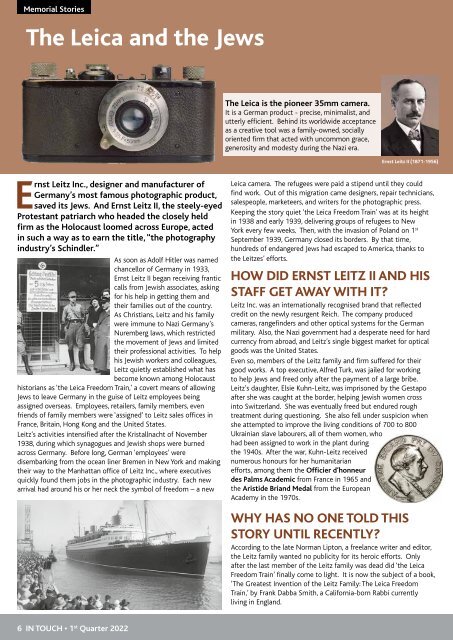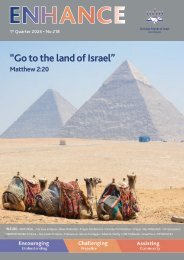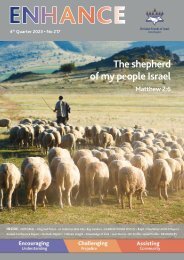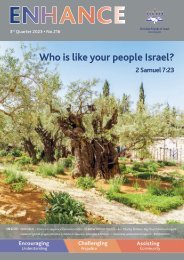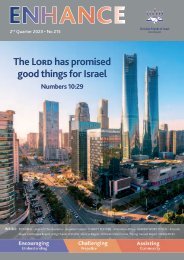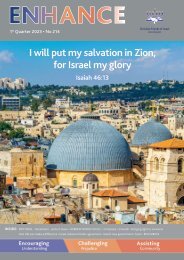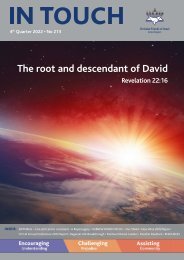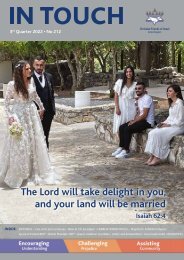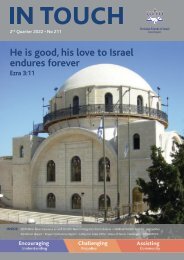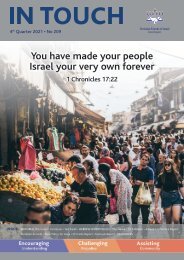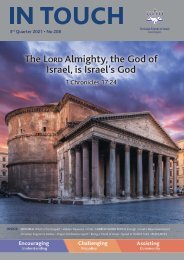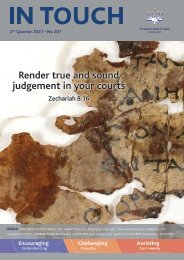In Touch - 1st Quarter 2022
Articles on: the continuing biblical story of the Line and the Land; restoring to wholeness (shalom); Christians in Israel; the Leica camera and the Jews; what the Apostle Paul meant when he wrote, 'all Israel will be saved'; the special story of one particular fiddle; CFI UK’s new Echoes of Sorrow exhibition; and Yair Lapid's aim to establish a coalition of nations opposed to a nuclear Iran.
Articles on: the continuing biblical story of the Line and the Land; restoring to wholeness (shalom); Christians in Israel; the Leica camera and the Jews; what the Apostle Paul meant when he wrote, 'all Israel will be saved'; the special story of one particular fiddle; CFI UK’s new Echoes of Sorrow exhibition; and Yair Lapid's aim to establish a coalition of nations opposed to a nuclear Iran.
- No tags were found...
Create successful ePaper yourself
Turn your PDF publications into a flip-book with our unique Google optimized e-Paper software.
Memorial Stories<br />
The Leica and the Jews<br />
The Leica is the pioneer 35mm camera.<br />
It is a German product - precise, minimalist, and<br />
utterly efficient. Behind its worldwide acceptance<br />
as a creative tool was a family-owned, socially<br />
oriented firm that acted with uncommon grace,<br />
generosity and modesty during the Nazi era.<br />
Ernst Leitz II (1871-1956)<br />
Ernst Leitz <strong>In</strong>c., designer and manufacturer of<br />
Germany’s most famous photographic product,<br />
saved its Jews. And Ernst Leitz II, the steely-eyed<br />
Protestant patriarch who headed the closely held<br />
firm as the Holocaust loomed across Europe, acted<br />
in such a way as to earn the title, “the photography<br />
industry’s Schindler.”<br />
As soon as Adolf Hitler was named<br />
chancellor of Germany in 1933,<br />
Ernst Leitz II began receiving frantic<br />
calls from Jewish associates, asking<br />
for his help in getting them and<br />
their families out of the country.<br />
As Christians, Leitz and his family<br />
were immune to Nazi Germany’s<br />
Nuremberg laws, which restricted<br />
the movement of Jews and limited<br />
their professional activities. To help<br />
his Jewish workers and colleagues,<br />
Leitz quietly established what has<br />
become known among Holocaust<br />
historians as ‘the Leica Freedom Train,’ a covert means of allowing<br />
Jews to leave Germany in the guise of Leitz employees being<br />
assigned overseas. Employees, retailers, family members, even<br />
friends of family members were ‘assigned’ to Leitz sales offices in<br />
France, Britain, Hong Kong and the United States.<br />
Leitz’s activities intensified after the Kristallnacht of November<br />
1938, during which synagogues and Jewish shops were burned<br />
across Germany. Before long, German ‘employees’ were<br />
disembarking from the ocean liner Bremen in New York and making<br />
their way to the Manhattan office of Leitz <strong>In</strong>c., where executives<br />
quickly found them jobs in the photographic industry. Each new<br />
arrival had around his or her neck the symbol of freedom – a new<br />
Leica camera. The refugees were paid a stipend until they could<br />
find work. Out of this migration came designers, repair technicians,<br />
salespeople, marketeers, and writers for the photographic press.<br />
Keeping the story quiet ‘the Leica Freedom Train’ was at its height<br />
in 1938 and early 1939, delivering groups of refugees to New<br />
York every few weeks. Then, with the invasion of Poland on 1 st<br />
September 1939, Germany closed its borders. By that time,<br />
hundreds of endangered Jews had escaped to America, thanks to<br />
the Leitzes’ efforts.<br />
HOW DID ERNST LEITZ II AND HIS<br />
STAFF GET AWAY WITH IT?<br />
Leitz <strong>In</strong>c. was an internationally recognised brand that reflected<br />
credit on the newly resurgent Reich. The company produced<br />
cameras, rangefinders and other optical systems for the German<br />
military. Also, the Nazi government had a desperate need for hard<br />
currency from abroad, and Leitz’s single biggest market for optical<br />
goods was the United States.<br />
Even so, members of the Leitz family and firm suffered for their<br />
good works. A top executive, Alfred Turk, was jailed for working<br />
to help Jews and freed only after the payment of a large bribe.<br />
Leitz’s daughter, Elsie Kuhn-Leitz, was imprisoned by the Gestapo<br />
after she was caught at the border, helping Jewish women cross<br />
into Switzerland. She was eventually freed but endured rough<br />
treatment during questioning. She also fell under suspicion when<br />
she attempted to improve the living conditions of 700 to 800<br />
Ukrainian slave labourers, all of them women, who<br />
had been assigned to work in the plant during<br />
the 1940s. After the war, Kuhn-Leitz received<br />
numerous honours for her humanitarian<br />
efforts, among them the Officier d’honneur<br />
des Palms Academic from France in 1965 and<br />
the Aristide Briand Medal from the European<br />
Academy in the 1970s.<br />
WHY HAS NO ONE TOLD THIS<br />
STORY UNTIL RECENTLY?<br />
According to the late Norman Lipton, a freelance writer and editor,<br />
the Leitz family wanted no publicity for its heroic efforts. Only<br />
after the last member of the Leitz family was dead did ‘the Leica<br />
Freedom Train’ finally come to light. It is now the subject of a book,<br />
‘The Greatest <strong>In</strong>vention of the Leitz Family: The Leica Freedom<br />
Train,’ by Frank Dabba Smith, a California-born Rabbi currently<br />
living in England.<br />
6 IN TOUCH • 1 st <strong>Quarter</strong> <strong>2022</strong>


